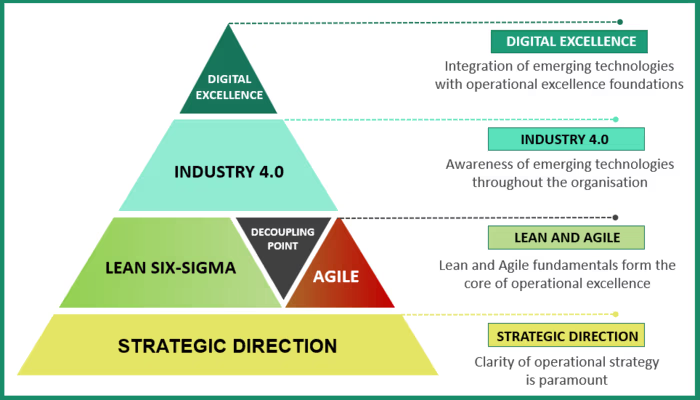Summary: Operational excellence in the digital age is not about replacing established practices with new technologies. Instead, it’s about evolving these practices to harness the potential of Industry 4.0. By aligning strategy, Lean Six-Sigma, and Agile principles with digital innovations, organisations can eliminate waste, enhance processes, and achieve digital excellence.
I believe this is so important that I have spent years evolving my MBA research project into a comprehensive training programme that explores each of these steps towards operational excellence in much more detail, aimed at providing practical frameworks and tools for organisations and consultants to follow to ensure success in this complex digital world.
Find me on LinkedIn for more information.
Follow here: https://www.linkedin.com/in/jonathanpickersgill/
Introduction: The Evolution of Operational Excellence
The world of operations is undergoing a transformation. We are widely regarded to be in the midst of the Fourth Industrial Revolution, also termed Industry 4.0. This is reshaping industries, and achieving operational excellence in this digital age requires a nuanced understanding of how to integrate these advancements effectively.
The foundations of operational excellence can be summarised with established models such as Lean, Six-Sigma, and Agile. These remain crucial, but their application must evolve to align with the opportunities presented by Industry 4.0. Let’s delve into how to approach this challenge.
How Do We Know We’re in an Industrial Revolution?
Industrial revolutions are transformative periods that redefine how we work, live, and interact with the world. By examining the characteristics of past industrial revolutions, we can better understand where Industry 4.0 fits and why it’s crucial for businesses to embrace it today.
Key Aspects of an Industrial Revolution:
1. Significant Change in Industrial, Social, and Economic Standards
Each industrial revolution has fundamentally altered the way industries operate, shifting societal norms and economic landscapes. Industry 4.0 is no exception. It is reshaping supply chains, creating smart ecosystems, and driving global connectivity while influencing broader societal trends such as remote working and more digitally oriented lifestyles.
2. Groundbreaking Technologies and Innovations
From steam power to mass production, industrial revolutions are characterised by technological leaps. Industry 4.0’s core technologies, such as AI, IoT, and advanced robotics, are pushing the boundaries of what’s possible, enabling live, data-driven decision making and unparalleled levels of automation.
3. Impact Beyond Industry
The ripple effects of industrial revolutions extend far beyond factory walls. With Industry 4.0, we’re seeing its impact on education, healthcare, energy consumption, and even how governments approach regulation. The shift to a digital economy is transforming society as profoundly as any previous revolution.
Based on these core definitions of an industrial revolution, it is clear to see how we are more than likely in the midst of one right now. Organisations that embrace Industry 4.0 technologies will thrive, leveraging innovation to stay ahead of the curve. Those that resist risk being left behind.
Did you know? There’s a smart Solution for Operational Excellence
Learn more about Operational Excellence Software
A Closer Look at Industry 4.0
Industry 4.0 can be summarised by three core aspects:
1. IT Integration
Integrating IT systems connects digital and physical assets across an organisation, enabling centralised data analytics for smarter, more informed decision-making.
2. Digital Connectivity
Enhanced digital networks, powered by the cloud, ensure a continuous flow of real-time information across operations, creating seamless communication and collaboration.
3. Innovative Technologies
A diverse array of pioneering technologies, including artificial intelligence, machine learning, big data analytics, and advanced robotics drive automation and optimization in smart factories.
A Smarter Approach to Operational Excellence
Operational excellence in the digital age is built on four key pillars. This is summarised in a framework I refer to as the Smart Operational Excellence Framework (SmartOps), developed through extensive research into the world’s best in this area
1. Clarity of Strategic Direction
Clear strategic goals are the foundation for determining how operations should be configured and which technologies to adopt.
2. Leveraging Lean, Six-Sigma, and Agile
These methodologies form the backbone of operational excellence. The challenge lies in selecting and adapting the most relevant elements to fit your strategy.
3. Harnessing Industry 4.0 Technologies
Awareness and understanding of these technologies across the organisation are vital for pragmatic and effective implementation.
4. Achieving Digital Excellence
This represents the culmination of strategic alignment, operational discipline, and the integration of advanced technologies.

How Industry 4.0 Enhances Lean Six-Sigma
As part of the extensive research conducted, Industry 4.0 has shown to open up many new opportunities to address the traditional 8 Wastes of Lean in innovative ways. Some examples of these solutions include automated vehicles equipped with AI to reduce transport waste, enhanced forecasting utilising big data to reduce inventory waste, and advanced robotics and machine learning to reduce defect waste which reduce errors in production processes. This approach introduces the concept of targeted solutions to enable cost effective digital transformations with clear return on investment.
When applied correctly, Industry 4.0 can further enhance the proven DMAIC process improvement framework (Define, Measure, Analyse, Improve, and Control), here’s a brief summary of how:
Define: Access to live data and integrated business systems not only help define the problem and connect teams, but can highlight the requirement for new projects and support justification for them in the first place.
Measure: Digital machine monitoring via PLCs connected to a data historians can help us develop live KPIs and establish robust baseline measures.
Analyse: An abundance of data needs a lot of analysis. Big data analytics can support the analyse phase and help us get to the root causes of problems.
Improve: Live data can expedite design of experiment and hypothesis testing. The range of technologies associated with Industry 4.0 can be selectively applied to improve the specific problems we are solving.
Control: Machine learning, supported by AI, can monitor and control processes with greater accuracy than ever before.
Achieving Digital Excellence: A Structured Approach
Digital transformation should be approached with the same discipline as any Lean initiative. Organisations must avoid digitising waste, as this only amplifies inefficiencies. Instead, the focus should be on:
- Building a clear understanding of strategic goals
- Systematically applying Lean, Six-Sigma, and Agile principles
- Pragmatically integrating Industry 4.0 technologies
The SmartOps Framework offers a practical roadmap for achieving digital excellence while maintaining operational discipline. Research shows that organisations adopting structured approaches to digital transformation achieve higher returns on investment and sustain improvements over the long term.
Images:
© elimicel / Adobe Stock
© IDOL’foto / Adobe Stock
© Sasint / Adobe Stock





